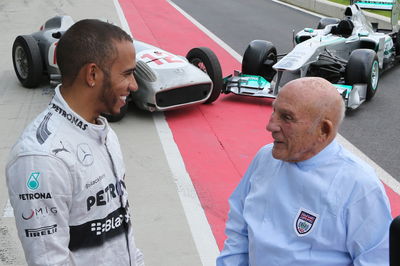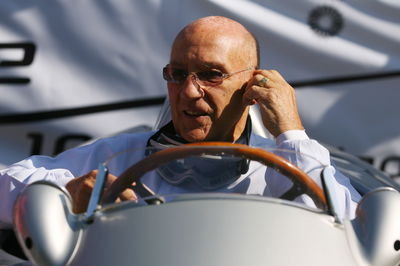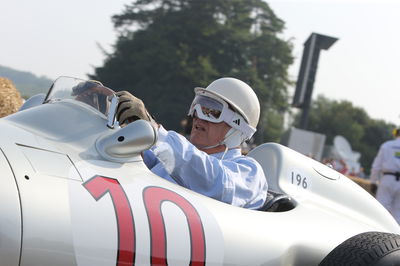Stirling Moss

Personal Information

About Stirling Moss
Stirling Moss F1 Career Overview
Broadly considered to be the greatest driver never to win an F1 World Championship, Stirling Moss’ lack of ultimate silverware doesn’t deny his status as one of the most talented and sporting drivers to ever grace the grand prix circuit.
Career Stats
Full Biography
Stirling Moss F1 Career Overview
Broadly considered to be the greatest driver never to win an F1 World Championship, Stirling Moss’ lack of ultimate silverware doesn’t deny his status as one of the most talented and sporting drivers to ever grace the grand prix circuit.
During an F1 career spanning 1955 to 1961 (full-time campaigns) Moss finished runner-up on four occasions and third on three occasions.
However, coupled with sportscar success - including a Le Mans 24 Hours win in 1956 - and the lucrative frequency with which he was victorious in ‘blue riband’ non-championship events, he ended his career with an extraordinary record of winning 212 of the 529 races he started across numerous disciplines.
Moss made his F1 debut in 1951 and raced sporadically for the next four seasons with HW, ERA, Connaught, Cooper and Maserati, the latter of which caught attention from Mercedes for a full season tilt in 1955 when he finished third in the Belgian Grand Prix.
Moss passed away on 12 April 2020 at the age of 90 after a long illness
Stirling Moss F1 Career - Team-by-Team
Mercedes: 1955
Though it was his 17th grand prix, the start of the 1955 F1 World Championship season marked Moss’ first full-time berth at the wheel of the Mercedes W196 alongside Juan Manuel Fangio. It was an eye-catching debut for Moss despite the continued dominance of his Argentine counterpart, notching up podiums in Belgium and the Netherlands before claiming a popular first victory in the British Grand Prix at Aintree on route to second overall.
Maserati: 1956-1957
A switch to Maserati machinery - which he drove in 1954 - brought further success with wins in the Monaco Grand Prix and the team’s home Italian Grand Prix, once again running Fangio close but leaving him unable to loosen his rival’s grip on the overall crown.
Vanwall: 1957-1958
After starting the season in a Maserati, Moss switched to Vanwall machinery for the remainder of the season and despite failing to score in the opening four rounds (including non starts in the Indy 500 and French Grand Prix), Moss was untouchable to the end of the year with three wins in four races.
This included a celebrated victory in Italy on the 15.99 mile Pescara Circuit, a fearsome endurance race in which Moss defeated Fangio by a full three minutes over three hours racing. The late season rout wasn’t enough to prevent Fangio’s fifth World Championship, Moss forced to settle for the runners-up spot for a third season in succession.
With the 1958 F1 World Championship expanding from eight to 11 races, Moss made a brief switch to Cooper - earning him victory in the season-opening Argentine Grand Prix - before returning to Vanwall machinery. Wins in the Netherlands, Portugal and Morocco followed but once again Moss would fall just short, by a single point, this time to Mike Hawthorn.
Gallingly for Moss, it was his sportsmanlike intervention during the Portuguese Grand Prix that cost him the title after arguing in Hawthorn’s favour that he did not contravene the rules in an off that originally had him thrown out of the results. Moss’ testimony saw Hawthorn reinstated, earning him enough points back that would ultimately deny his countryman.
Cooper / BRM: 1959-1960
A combination of Cooper and BRM machinery underpinned Moss’ 1959 campaign with more wins coming in Portugal and Italy but he’d lose out in a three-way battle between himself, Jack Brabham and Tony Brooks, ending up third 5.5 points off the top spot.
Lotus: 1960-1961
Driving a Cooper in the opening Argentine round but receiving no points because he shared driving duties (now no longer permitted officially), Moss made his debut with Lotus during the 1960 Monaco Grand Prix and won.
However, his season was spoiled by an accident during the Belgian Grand Prix in which he was thrown from his car, breaking both of his legs. He made a return for the final round and was triumphant at Riverside, his two wins from three starts enough to still earn him third overall.
Moss’ final season - once more with Lotus - drew more success in Monaco and Germany, but DNFs elsewhere slowed his hopes of a title challenge and yet again he’d end up third overall.
Stirling Moss - Beyond F1
As was the norm in the 1950s and 1960s, Moss supplemented his F1 driving duties with a series of performances in a variety of machinery and disciplines, earning him a reputation as one of motorsport’s most passionate and versatile racers.
Competing in a variety of non-championship grands prix, victories include the RAC Trophy, the Glover Trophy, the Aintree 200, the BRDC Trophy, the International Gold Cup, the Caen Grand Prix, the Vienna Grand Prix and the Silver City Trophy.
He was also a renowned endurance racer, winning the 1956 Le Mans 24 Hours alongside Peter Collins in an Aston Martin DB3S, twice a winner in the Sebring 12 Hours, the 12 Hours of Reims and the iconic 1955 Mille Miglia for Mercedes.
Prior to his F1 career taking off, Moss also competed in the Rallye de Monte Carlo, finishing second at the wheel of a Sunbeam-Talbot 90. He returned to full-time racing in 1980 in the British Saloon Car Championship (forerunner to the BTCC), finishing sixth in class driving an Audi 80 GLE for Tom Walkinshaw Racing.
Moss passed away aged 90-years old on 12 April 2020 at home in London following a long illness
Latest Videos
Latest Photos



